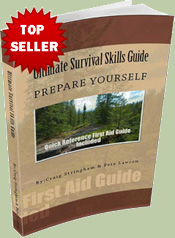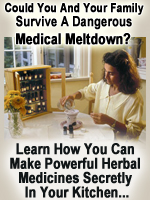George Ure and Gaye Levy, Contributors
Activist Post
For the past week, George’s son (who we call G3) has been job-hunting and working with his dad at the ranch in East Texas. He missed the snow and ice storm back home in Seattle (doggone him) but being in Texas gave the two George’s some time to bounce around ideas about what’s really important. You know: father and son stuff.
So, while they were talking, the subject of prepping to save lives came up.
Of course both are diehard preppers, but when it comes to saving lives the younger George is the expert. Today we share his thoughts on what he likes to call “lifesaving prepping”.
The more medical supplies you have the better
George aka G1: Do people have any idea how seriously under-prepared they are – both in terms of materials and brainpower to deal with a medical emergency?
The younger George aka G3: I work as an EMT, and oftentimes patients and/or their families thank us for saving a loved one or for just doing a good job. What they don’t realize is that we are absolutely nothing without our equipment and our supplies. With our equipment we are a lean mean lifesaving/disability preventing machine. Without our equipment and our gear we are just regular guys and gals in good-looking uniforms who know a lot about hands-on first aid.
G1: Can you share with our readers some of the must have equipment and supplies that are needed in an emergency situation?
G3: Yes, of course. I could go on and on about the exact supplies you would need, but for the sake of not making this article too long I will give you the short-list:
- Wound care supplies: All kinds of bandages, ranging from regular size Band-Aids to huge abdominal pads.
- Broad spectrum antibiotic cream/ointment (AND LOTS OF IT!)
- Q-tips
- Sterile saline wound wash,
- Tongue depressors (these are great for splinting fingers and applying antibiotic cream)
- Medical tape of all different sizes
- Containers of bleach (lots of uses for bleach, from making water drinkable to disinfecting just about anything)
- A GSW (gunshot wound) kit, this contains
- chest seals
- tourniquet
- a rapid clotting agent (like Quikclot which is available at Amazon)
- medical instruments (forceps, tweezers & scissors)
- Israeli Battle Dressing (6-inch)
- Soap (the more the better)
- Surgical scrub (Betadine surgical scrub)
- Tampons
- Digital and regular thermometers
- Over the counter medications:
- ibuprofen
- diphenhydramine
- acetaminophen
- Pepto Bismol
- cold medicine (with nasal decongestant)
- Splinting supplies (you don’t really have to buy these you can make a good splint out of anything if you are creative)
- Epinephrine mist (last resort asthma and anaphylactic shock treatment)
- Blood Pressure Monitor
- Portable Defibrillator (AED)
That is a short-list just to get you started and to get an idea of the kinds of things you will need. There’s more, but first you need to get the knowledge committed to memory of what to use when.
Which means . . .
Learn as much as you can about medicine
G1: How much time should a person spend learning medicine basics?
G3: As much as it takes. Let me explain that a bit.
Medicine covers a vast area of subjects, so here is a starting list of things you should study now and be proficient in:
Basic first aid. This is the starting point for your medical training and an important subject. Let’s say you’re out cutting little pieces of wood into kindling, you have a slip of your knife and you cut yourself. It’s not a big cut, but if you don’t clean it and bandage it like you’re supposed to, then it could become infected and you may end up losing your finger, hand or lower arm due to infection. Yes a little tiny cut can turn into a raging infection (I have seen it and it is not a pretty sight).
So, if you get a cut, you want to clean it with soap and water (or irrigate with sterile saline or various wound washes that are available on the market these days). Then you want to apply some kind of broad-spectrum antibiotic cream (like Neosporin, or the generic version, and keep it covered with a sterile bandage. You also want to clean it daily, applying fresh antibiotic cream with a new bandage daily as well. (Your first lesson – on the house.)
Emergency medicine: Read an EMT text book, or even take an EMT class. This will give you the basics on how to care for yourself or someone else.
Continued study: After you read an EMT text book and/or take an EMT class and you want to go to the next level in understanding emergency medicine, I recommend reading this book: Emergency Pathophysiology: Clinical Applications for Prehospital Care, by Samuel M., Jr. Galvagno. The book takes everything you learned in EMT class and breaks it down on the physiological level, yet it is easy to understand. It will also help you understand medicine better overall.
Public Health: Yes! This is an area of medicine! It is a broad subject, but the areas you need to focus on are sanitation and disease prevention. Where to put the latrine and how to maintain it. How to protect yourself from getting an airborne virus / bacteria, how to prevent getting an STD or even HIV (even when the world is ending people are still going to be having sex and if you get an STD and there is not treatment available you are going to suffer greatly or die). Another tip: make condoms and lubricant part of your kit.
General medicine: There is an excellent guide called Healthwise Handbook Take Charge of Your Health that is a good manual for common medical issues that arise.
Pharmacology: Before I give any patient a medication I always ask, “Do you have any drug allergies?’ You should also adopt this life-saving habit. The first rule in medicine: DO NO HARM. The more you know about medications the better. Here is a link to a free e-book from the Wilderness Medicine Training Center to help get you started: Basic Pharmacology.
Also, here is another a very good book about medications: The Pill Book: New and Revised.
G1: I have to put in a pitch for a book – which of all of them I’ve read – that gave me the best insight into the public health and immunological issues which might accompany a society-threatening event: “Control of Communicable Diseases Manual’ which is a follow-on sourcebook to the Abram Benenson classic “Control of Communicable diseases in Man” from back in the mid 1980s.
Health conditions and medications
G1: What about getting ahead of problems before the worst case shows up?
G3: Before the worst happens, you need to know your own health status; and if you do have a health condition, you need to fully understand it and get it fully under control. For example: I have asthma, which a lot of people don’t know that about me. Why is that? Because I completely control it with the proper medications.
We all as preppers understand that if the worst-case scenario happens, medications will be hard to come by (if at all), so I keep at least a year’s supply of the medications I need.
G1: I’m glad you touched on that. I know people who are insulin and tissue rejection medication-dependent that keep a 2-4 years of meds on hand and rotate through them.
G3: I also hoard every prescription medication I can get my hands on, because maybe someday I or someone else I am taking care of will need it. But if you start hoarding meds, you need to know when and how to use that and at the correct dosages! If you have extra antibiotics in your supplies, you better know everything about them, like if they are for gram negative or gram positive bacteria, what type(s) of infections they treat and, like I said before, the correct dosages.
If the worst happens, prevention is key.

G1: You and I don’t see eye to eye on vaccines. I tend to be a “no thanks” guy, but I know you have more faith in medicine and don’t look at the world through the financial glasses like I do. So, what’s your take on vaccinations?
G3: You are a worrywart. Worry about the right problem, dad. First off, I recommend that you get up to date on all your vaccines. I know with certain groups of people (like you and Gaye) vaccines are a hot issue, yet I have had more vaccines then anyone I know. I have even had some that were and still are experimental.
These are all the vaccines I have had (and nothing is wrong with me!):
- Hepatitis A+B
- Meningococcal (meningitis)
- MMR, (measles, mumps, and rubella)
- Pneumococcal polysaccharide (pneumonia vaccine)
- Herpes Zoster “shingles”
- Tdap (diphtheria, tetanus, and pertussis)
- Varicella vaccine (get this if you have not already had the chicken pox)
The key thing is I am – and keep – current on all of these. I work as an EMT/patient care technician with the local public health department and when the H5N1 (bird flu) scare happened, I received the experimental vaccine for that, And speaking of influenza, I get a flu shot every year.
If you can prevent it, prevent it! The old saying “An ounce of prevention is worth a pound of cure.” Working in healthcare really drove that that into my thick skull.
Side note from Gaye aka G2: I have to agree with G1. I am a “no thank you” type of gal myself. My recommendation? Research and educate yourself first, then have a heart-to-heart discussion with your personal physician. If you are against a vaccine, stay the course and be 100% convinced before taking the plunge. Me personally? Except for Tetanus, I am vaccine-free.
G1: One thing you did not mention is to watch for vaccines that have mercury-based preservatives in them. A typical allergy (which I have) is to Thiomersal.
On the other hand, I do keep my Tdap current, since there’s always something rusty around the ranch here. And a loudmouth like me never wants to see lockjaw.
G3: Got that right! Also pay attention to what you are doing and use good judgment! People take a lot of risk driving fast and doing other things that could turn out tragic, but if it all comes falling down, that emergency room that was ten miles from your home will not be there anymore.
So, drive slower, watch your step and don’t put yourself in a situation where you could become injured. You could be walking in a field, not paying attention to the terrain, trip on and large root and now you have a broken wrist and there will be no one who can fix it. And all because you were not paying attention!
Or, you could be walking out of harm’s way and step on a snake. You can get basic snakebite kits, but people seldom think of that. It is really is amazing to me as a healthcare professional.
You may get tired of me saying this, but here it comes again: “An ounce of prevention is worth a pound of cure.” How this applies is this:
When no help is available, every action and every step must be thoroughly thought through and within the range of actions based on supplies on hand. Otherwise, best case you’re miserable and worst case you’re dead.
Moving someone up to a higher level of care
G1: OK, suppose something really ugly happens: Nuclear terrorism, global war, bird flu goes airborne, something like that. What then?
G3: As an EMT, it is my role to assess a patient, stabilize them and then move them on to a higher level of care. Over the years, I have developed a very good sense for which patients need to get to the ER immediately and which are stable enough to treat on scene.
EMTs doing box-time (riding mobile units) call this “Load and go!” or “Stay and play.”
Someone you’re caring for may get so sick or injured that nothing you do will improve their current situation and that is why you need to have a plan to get that someone to a place that has the capabilities that will improve their condition, or even save their life.
Another saying we have in EMS regarding traumatic injuries is this: “We don’t save victims of trauma, the operating rooms does!” We get them stable and get them moved up the medical food chain.
G1: Goes without saying that taking an inventory of doctors within a 3-mile range of your home would make sense.
Communications in an Emergency
G1: That gets us to how are you supposed to find help when there’s pandemonium all about?
 G3: In the worst-case scenario you will have no cell phone, no house phone and no Internet. That is why you need to become an expert in other forms of communication. Amateur / ham radio, GMRS, commercial radios and CB radio are all things you should have at your disposal. You should also be (or have access to) an expert in knowing how to use the different radio services.
G3: In the worst-case scenario you will have no cell phone, no house phone and no Internet. That is why you need to become an expert in other forms of communication. Amateur / ham radio, GMRS, commercial radios and CB radio are all things you should have at your disposal. You should also be (or have access to) an expert in knowing how to use the different radio services.
This applies double to medical emergencies, which happen as a subset of larger emergencies (flood, tornadoes, earthquakes, terrorism) because you can’t call for help if you don’t have the right equipment to do it with.
G2: And for ideas on communications, our last two weeks of discussion of ham radio might be worthy of review: here and here.
And to Summarize it All
The Two Gs, George and Gaye, would like to thank the younger George for sharing his thoughts on prepping to save lives. And the take away? Peruse the list of supplies and compare them to what you have already set aside in your emergency medical kit. Read up and educate yourself so that you are prepared with knowledge to act appropriately and quickly if needed.
And last? Pay attention, be alert, and above all, be prepared.
Hang on and enjoy the ride….
Introducing Strategic-Living: a practical and useful online magazine providing inspiration and guidance as we make our way through the maze of changes that are coming our way. In collaboration with my friend and colleague, George Ure, Strategic-Living will offer a synthesis of Urban Survival and Backdoor Survival with much more detailed tips, tools and strategies for creating a vibrant and sustainable lifestyle wherever your path may take you. Think of Urban Survival and Backdoor Survival as your roadmap and Strategic-Living as your detailed guidebook. Here you will find articles and photos, diagrams and how-to’s, and a healthy dose get-out-there and do it with kick-in-the-ass inspiration.
linkwithin_text=’Related Articles:’








Be the first to comment on "Saving Lives: Thoughts of an EMT (with reading list)"